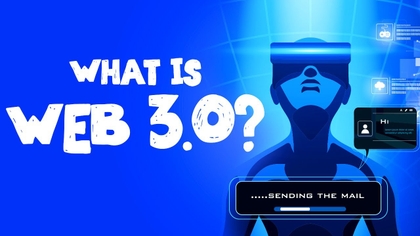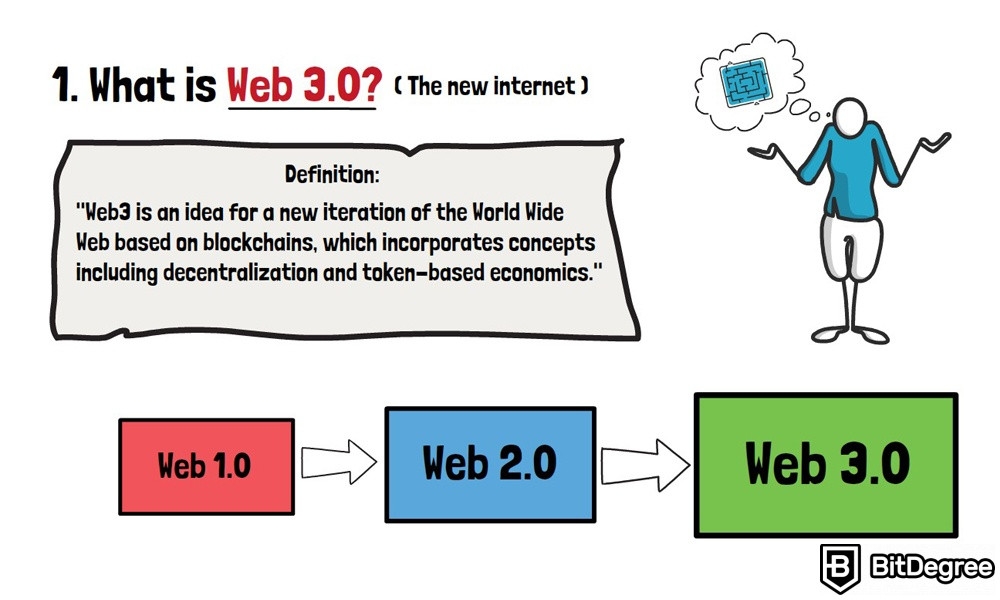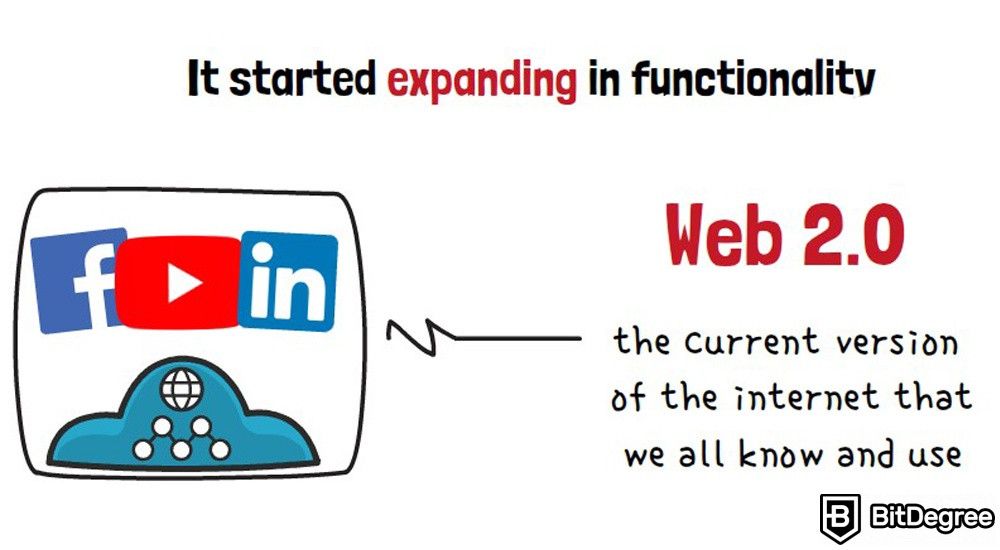6.5 Web 3.0: The Future of the Internet
Free Airdrop Season 7 is LIVE! Answer fun questions or do simple tasks to earn rewards from the $30K BitDegree prize pool. Participate Now ! 🔥
Everywhere you look online, it seems like the term “Web 3.0” keeps popping up, in one context or another. It has come to a point where even my friends, who otherwise have nothing to do with crypto, are asking me - what in the world is this “Web 3.0” that we keep hearing about?
I have to admit - it’s not a simple question to answer! There’s no one, set definition for the term, and experts seem to use advanced tech-speak and complicated terminology when defining the concept. Well, I’m up to the challenge - we’ll try to discuss the topic in an easy-to-understand manner.
We’ll be focusing on Web 3.0. Specifically, I’ll be answering questions such as what Web 3.0 is, how it works, and how Web 1.0 & Web 2.0 are different from Web 3.0.

Video Explainer
Video Explainer: Web 3.0: The Future of the Internet
Reading is not your thing? Watch the "Web 3.0: The Future of the Internet" video explainer
What is Web3? (Animated Explanation + Examples)


What is Web3?
According to the fancy definition:
Web3 is an idea for a new iteration of the World Wide Web-based on blockchains, which incorporates concepts including decentralization and token-based economics.
But what does Web3 actually mean?

As with most seemingly-complex topics, in order to understand Web 3.0 - also known as “the new internet” -, we should probably first explore the earlier iterations of the concept - namely, Web 1.0, and 2.0.
Web 1.0
Web 1.0 can be viewed as the very beginning of the internet. It’s kind of mutually agreed upon that this version of the web lasted from the 1980s, up to the early 2000s. The defining characteristic of this form of the web is the fact that users were only able to view the information online, without really being able to customize their experience while doing so. Let’s call it - “The Read Only” Internet, where users were CONSUMERS of the data.
In general, even this was a completely new concept. People would be used to accessing all of their information in newspapers and books - Web 1.0 basically digitalized this experience.

Specifically, you could visit static web pages, and read up on topics that interested you. In most cases, you couldn’t create personal profiles, and your whole browsing experience would be directed around accessing the information that you’re searching for. In other words, there was nothing “personal” about this form of the internet - it purely revolved around consuming the information.
Being a completely new concept, naturally, Web 1.0 had a lot of obvious downsides. One of them, as I just mentioned - lack of personalization. However, this version of the internet experience was also very slow, and users would have to possess a lot of patience in order to receive or send a piece of information.
Web 2.0
With time, as the internet became more and more popular, it started expanding in functionality, too. The rise of social media platforms and data collection channels marked the beginning of what we now call Web 2.0 - in other words, the current version of the internet that we all know and use.
If you were to ask what defines this version of the web? The answer would be - you.
Web 2.0 brought the ability to INTERACT, not just to consume. Like to create social profiles, identify yourself to large tech companies, and thus, customize your experience on the internet. The web became much more personal, with your browsing experiences tailored to your personal preferences, wants, and needs. User connections and social participation became the key factors of this form of the internet.
The whole idea and purpose of the internet was changed. Web 2.0 is more about showing yourself by sending or receiving data instantly via live streams, video sharing, or instant messaging. The content type was transformed from static to dynamic. Data became instantly accessible.

Facebook and Google are the usual examples when it comes to the earlier-mentioned companies. These two brands are data collection and personalization GIANTS - it has come to a point where you could say that they know what you like and dislike better than you do, yourself!
The platforms collect and analyze your information, and then sell it off to third-party advertisers so that they could do a better job at targeting their ads at you. These processes have become so advanced that you might simply think about wanting to purchase a plush teddy bear, and start seeing ads for your local toy store the next day!
Now, naturally, there’s no “black magic” involved. However, such joke-examples just go to show how much personal info we give up, and how far the aforementioned processes have come over the years.

As you can probably imagine, the biggest concern for Web 2.0 is user data privacy. While we do actively choose to give up our personal information to these large data aggregation platforms, it has come to the point where people have started to search for alternative ways to use the internet - ways that wouldn’t involve centralized institutions controlling everything that we see online.
This is where the concept of Web 2.0 VS Web 3.0 comes in.
Web 3.0
The simplest definition of Web 3.0 is a “decentralized internet”. It’s a form of the web that would allow users to frankly remain anonymous while using it, and only share data that they themselves feel comfortable with sharing. That said, this form of the internet would also be much faster, and utilize data analysis. The Internet will become smarter because of quantum-computers and self-learning algorithms or AI.
The experience of the Web 3.0 internet will also change. We will start hearing more about the Metaverse, Virtual or Augmented Realities as a data medium. Data types will go from purely dynamic to live data, and, in most cases, will change and be produced instantly, on the go.
Web 3.0 wouldn’t be controlled by any of the earlier-mentioned centralized institutions. Instead, it would be completely decentralized - meaning, lacking any central companies or brands that would dominate the space. So, no presidents or CEOs!
How is this possible? Well, currently, Web 3.0 is explored through the lens of crypto technology. For example, Bloomberg has also described Web3 as a concept that “would build financial assets, in the form of tokens, into the inner workings of almost anything you do online”.

Let’s get something straight - cryptocurrencies aren’t necessarily associated with Web 3.0, at least inherently. It’s perfectly possible to create a decentralized version of the internet without any of the currently-existing crypto assets. That being the case, though, cryptocurrencies and the technology behind them help to conceptualize this goal much easier.
Now, cryptocurrencies are built on blockchains - let’s call them, special databases that are mostly decentralized. In order to earn cryptocurrencies, oftentimes, you have to participate in a process known as “mining” - basically, you need to plug your computer into the network, and dedicate its resources for calculations, to help confirm the transactions happening on the said cryptocurrency's blockchain.
This way, you become an active participant in the network and help keep it decentralized.
Lastly, in order to send and receive cryptocurrencies, you need a wallet - an app where your crypto assets are able to be kept safe and sound. Each wallet has two codes - a public address, and a private key. The former is used for transacting with cryptocurrencies, while the latter is your secret key that is used to access the wallet, in the first place!
I promised not to get too much into tech difficulties, so I’ll stop here. But why do I tell you all of this?
Simply because all of these terms and concepts are relevant to Web 3.0!
Within Web 3.0, individuals would probably use their cryptocurrency wallets in place of social profiles. These wallets would be used to verify your profile, and log onto certain websites, as well as to confirm actions that you’d perform on the internet - liking your friend’s profile picture, purchasing a digital drawing, or participating at a pop star gig in a Metaverse. Blockchain technology would help to perform all of these processes anonymously.

Now, naturally, as you can probably imagine, a decentralized version of the internet would bring with itself a lot of trouble, among other things. One of the benefits of our current version of the web is the fact that there’s strict moderation involved, and illegal content is quickly removed from the mainstream websites.
Who would moderate such websites if the web would be lacking any central authority? This is where the concept of “DAOs” comes in.
A “DAO” is a “Decentralized Autonomous Organization”. The term sounds very fancy, but the idea itself is actually rather simple to understand, fundamentally.
Imagine that, in Web 3.0, each website would have a dedicated cryptocurrency of its own (these would be known as Web 3.0 coins). If you would own some of that cryptocurrency, you could participate in the decision-making processes of that website - what content to leave up and what to remove, what should be the color scheme of the site, should there be a paywall for users to be able to join, and so on.
Together with other holders of said cryptocurrency, you would be able to vote on the important questions relating to that website. This would form the aforementioned DAO - a decentralized organization that makes the core decisions behind how a website functions.

Before we continue, let’s have a quick overview of what we’ve already discussed, up to this point.
Web 3.0 is a decentralized version of the internet. It’s a conceptualized follow-up of Web 2.0, the current form of internet that you and I are familiar with. Web 3.0 aims to tackle things such as data privacy, large corporate entities controlling what we see on the internet, and, most importantly, user privacy. Also, it will bring us to the new mediums of data experience with Meataverses, VRs, and instant data aggregation.
While Web 3.0 does not require cryptocurrencies to function, theoretically, the concept itself is much easier to understand when you learn how blockchains and crypto wallets work. This allows you to imagine how cryptocurrency wallets could replace online profiles, and how DAOs could be the answer to keeping things civil and legal.
One more thing that you need to be aware of is something known as “the Web 3.0 Foundation”. Admittedly, it sounds like the core organization behind Web 3.0, right?
Well, it’s not, really. The Web 3.0 Foundation is a group that aims to “support different projects that want to increase decentralization on the internet”.
A noble mission - indeed! However, the organization is often criticized for being rather biased. For example, it offers grants to developers, but only those who would use the popular cryptocurrency Polkadot’s blockchain to create their projects. The entirety of the foundation itself is centered around said blockchain, so you can see why there are people who aren’t too excited about this organization.
This leads me to my final point and something that I want to leave you off with. As I’ve hinted at throughout the entirety of this section, as of now, Web 3.0 is still just a rough idea, and a concept. Meaning, while there are theories of what this version of the internet should look like, and ideas of how it can be developed, it’s still very much in its infancy stage!
Following that, many companies and organizations may try to capitalize on this, and influence how people view the concept, in the first place. Do not fall for it! While the idea of a decentralized web is very exciting, there are still many, many questions that need to be answered, and problems that need to be tackled until this concept becomes even remotely viable. Such as, what will happen if the biggest part of DAO’s votes will be concentrated in one person’s hands? Do we get back to the centralized internet? How to avoid that?
And so, that’s it! If you would like to learn more about the world of crypto, check out the section - "What are NFTs?"










